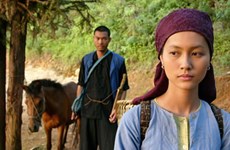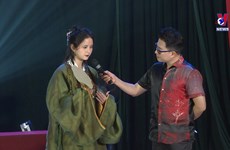Muong dance teacher embraces rhythm of life
"If you haven't eaten grilled chicken or watched Thai dancing, you
haven't been to Son La," said one indigenous man in this quiet mountain
town.
"If you haven't eaten grilled chicken or watched Thai dancing, you
haven't been to Son La," said one indigenous man in this quiet mountain
town. His sentence summed up the foggy night. In the flickering flames,
everyone was a bit intoxicated.
Xoe dances are a unique custom of the Thai people, especially in the Northwest region. There are approximately 30 dances, which serve to express unity, friendship and sharing. All the Thai know how to dance xoe.
Each dance has its own unique features, but they are very simple and easy to learn, so anyone can join the dance.
Lo Van Pien, a local Thai dance master, says the Thai usually perform five xoe dances during each festival. "Some require just a few dancers, while others call for a dozen or more performers," he said.
The first dance is “kham khan moi lau,” an invitation to neighbours to drink rice wine. Women dance around a large jar of alcohol, holding handkerchiefs to demonstrate the family's hospitality to their guests.
The “pha xi” is a dance about the four corners of the Earth. The music becomes more powerful and animated and men take their places at the corners to pray for happiness and luck. The dance means "We'll miss each other when we're separated, but we'll always meet again."
Both men and women perform the “lon hon”, which means, "Life is full of ups and downs, but brothers cannot be separated."
Women perform the “nhom khan”, a joyful dance also popular at housewarming parties and weddings. Everyone holds hands in a circle and claps at intervals during the om lom top mu, a dance about the universe and the solidarity of the community.
The dances have become a specialty of the northwestern province of Son La, used frequently to welcome visitors. This is due in large part to the work of Excellent Artist Dinh Cong Pon, a dancing teacher born in Phu Yen District in the Son La mountains.
Pon, who has been a mentor to many generations of students in the region and also choreographs traditional dances in many local events, has made efforts to preserve the custom. Although he is a member of the Muong ethnic group, his love for the Thai people's dances penetrated into him so gradually that he was not even aware of it happening - like groundwater seeping into land, or the river's silt absorbing water.
Although the traditional dances of the Thai are mostly for women, who attract viewers with their flexible bodies, Pon has known how to dance since he was a schoolboy.
"I saw people dancing, then I took an interest and learned how to dance on my own, without teachers or classes like young people have today," said Pon.
When the teachers of the Vietnam Dance School arrived in Son La to recruit trainees, Pon was a seventh-grader. His friends took the test for the dancing school, and he decided to go along as well.
"I was just following my friends for fun," he said.
Yet in a twist of fate, Pon was the only candidate who was admitted.
When he told his family he planned to go to school in Hanoi, they were both happy and worried.
"Hanoi is so far," he recalled his mother saying. "Do you know the way to come back home to our mountainous village?"
His own mind was also confused. But when several teachers came to encourage him to go to school so that he could later help the Thai people preserve their folk dances for future generations, Pon decided to go to Hanoi.
In his early days in the capital city, everything was unfamiliar. But with help from teachers and friends, Pon completed the course.
After graduating, many of his friends wanted to settle in southern Vietnam because they thought it was the best place to develop a career. They asked Pon to go with them, but he refused and instead returned to his mountain homeland. His family lived there; moreover, he was still determined to preserve the Thai dances.
Pon joined the Ethnic Singing, Dancing and Music Troupe of Son La. The troupe travelled to many remote villages to create dance teams. They met elders who knew about Thai dances and helped them make the traditional art come alive again in the hearts of local people.
Thanks to these contributions, Pon's reputation spread widely. He was sent by the provincial authorities to attend the World Festival in the former Soviet Union, where he performed at the Vietnamese-Russian cultural exchange along with other Vietnamese artists.
He also danced for the soldiers protecting the northern border in the 1980s and gave many performances in Laos.
In 2001, Pon went to work at the High School for Culture, Arts and Tourism in Son La as head of the dance group of the school's Faculty of Arts.
"Although my art has turned in a new direction, my love for the Thai dances is still in my heart. In fact, this position gives me more chances to pass on my passion to students," he said.-VNA
Xoe dances are a unique custom of the Thai people, especially in the Northwest region. There are approximately 30 dances, which serve to express unity, friendship and sharing. All the Thai know how to dance xoe.
Each dance has its own unique features, but they are very simple and easy to learn, so anyone can join the dance.
Lo Van Pien, a local Thai dance master, says the Thai usually perform five xoe dances during each festival. "Some require just a few dancers, while others call for a dozen or more performers," he said.
The first dance is “kham khan moi lau,” an invitation to neighbours to drink rice wine. Women dance around a large jar of alcohol, holding handkerchiefs to demonstrate the family's hospitality to their guests.
The “pha xi” is a dance about the four corners of the Earth. The music becomes more powerful and animated and men take their places at the corners to pray for happiness and luck. The dance means "We'll miss each other when we're separated, but we'll always meet again."
Both men and women perform the “lon hon”, which means, "Life is full of ups and downs, but brothers cannot be separated."
Women perform the “nhom khan”, a joyful dance also popular at housewarming parties and weddings. Everyone holds hands in a circle and claps at intervals during the om lom top mu, a dance about the universe and the solidarity of the community.
The dances have become a specialty of the northwestern province of Son La, used frequently to welcome visitors. This is due in large part to the work of Excellent Artist Dinh Cong Pon, a dancing teacher born in Phu Yen District in the Son La mountains.
Pon, who has been a mentor to many generations of students in the region and also choreographs traditional dances in many local events, has made efforts to preserve the custom. Although he is a member of the Muong ethnic group, his love for the Thai people's dances penetrated into him so gradually that he was not even aware of it happening - like groundwater seeping into land, or the river's silt absorbing water.
Although the traditional dances of the Thai are mostly for women, who attract viewers with their flexible bodies, Pon has known how to dance since he was a schoolboy.
"I saw people dancing, then I took an interest and learned how to dance on my own, without teachers or classes like young people have today," said Pon.
When the teachers of the Vietnam Dance School arrived in Son La to recruit trainees, Pon was a seventh-grader. His friends took the test for the dancing school, and he decided to go along as well.
"I was just following my friends for fun," he said.
Yet in a twist of fate, Pon was the only candidate who was admitted.
When he told his family he planned to go to school in Hanoi, they were both happy and worried.
"Hanoi is so far," he recalled his mother saying. "Do you know the way to come back home to our mountainous village?"
His own mind was also confused. But when several teachers came to encourage him to go to school so that he could later help the Thai people preserve their folk dances for future generations, Pon decided to go to Hanoi.
In his early days in the capital city, everything was unfamiliar. But with help from teachers and friends, Pon completed the course.
After graduating, many of his friends wanted to settle in southern Vietnam because they thought it was the best place to develop a career. They asked Pon to go with them, but he refused and instead returned to his mountain homeland. His family lived there; moreover, he was still determined to preserve the Thai dances.
Pon joined the Ethnic Singing, Dancing and Music Troupe of Son La. The troupe travelled to many remote villages to create dance teams. They met elders who knew about Thai dances and helped them make the traditional art come alive again in the hearts of local people.
Thanks to these contributions, Pon's reputation spread widely. He was sent by the provincial authorities to attend the World Festival in the former Soviet Union, where he performed at the Vietnamese-Russian cultural exchange along with other Vietnamese artists.
He also danced for the soldiers protecting the northern border in the 1980s and gave many performances in Laos.
In 2001, Pon went to work at the High School for Culture, Arts and Tourism in Son La as head of the dance group of the school's Faculty of Arts.
"Although my art has turned in a new direction, my love for the Thai dances is still in my heart. In fact, this position gives me more chances to pass on my passion to students," he said.-VNA













